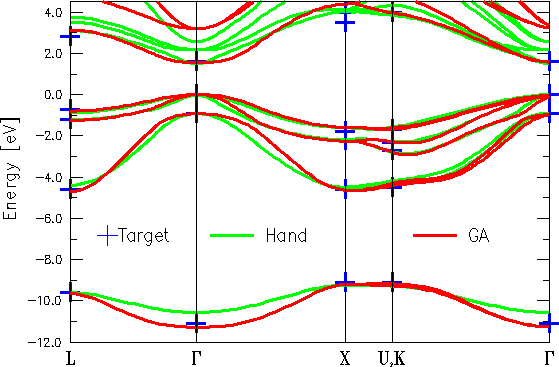
 |
Band-structure parameters by genetic algorithm |
![]()
 Fig. 1: Extended Hückel Theory band structures of CdTe fitted by genetic algorithm (red) and by hand (green). The target energies are shown by blue plus marks.
The Extended Hückel Theory (EHT) is an efficient tool to parametrize
Hamiltonian matrices to be used to calculate electronic energies in
crystals. Basis functions are made up of atomic orbitals.
The correct dependence of the energies in terms of the wave vector
(the "band structure") is known experimentally or from more demanding
calculations. Finding the parameters which will yield band structures close
to the "correct" ones by hand is a tedious task and often a frustrating
experience.
Genetic algorithms use biologically inspired methods to maximize a function
of several input variables. The values are described in a binary
fashion and joined to build a "string". For several strings the value of the
function is calculated and the values are compared. The best strings, the
"fittest", will survive and will be changed by "mutation" of single strings
and "cross-over" of two strings. The worst strings will be deleted. This
part is inspired by biological models of evolution.
We have used genetic algorithms to find the parameters of the EHT for a
number of crystals. A number of energies was given as target energies for a
few wave vectors. Fig. 1 shows by blue crosses the target energies as
determined from the literature for CdTe. The best manually fitted band
structure is the green line, the genetic algorithm found the parametrization
for the red band structure.
See also:
|
1996 Frank Starrost
![]()
 |